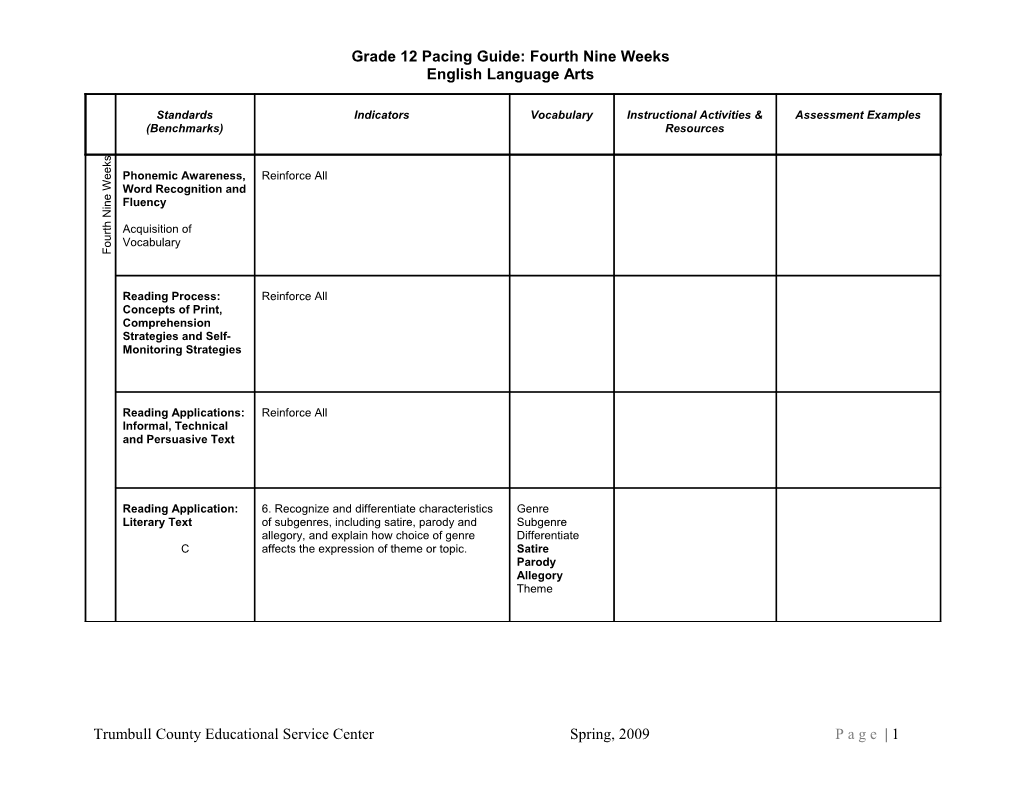Grade 12 Pacing Guide: Fourth Nine Weeks
English Language Arts
Standards (Benchmarks) / Indicators / Vocabulary / Instructional Activities & Resources / Assessment ExamplesFourth Nine Weeks / Phonemic Awareness, Word Recognition and Fluency
Acquisition of Vocabulary / Reinforce All
Reading Process: Concepts of Print, Comprehension
Strategies and Self-Monitoring Strategies / Reinforce All
Reading Applications: Informal, Technical and Persuasive Text / Reinforce All
Reading Application: Literary Text
C / 6. Recognize and differentiate characteristics of subgenres, including satire, parody and allegory, and explain how choice of genre affects the expression of theme or topic. / Genre
Subgenre
Differentiate
Satire
Parody
Allegory
Theme
Fourth Nine Weeks / Writing Processes
F
E
I / 15. Proofread writing, edit to improve conventions (e.g., grammar, spelling, punctuation and capitalization), identify and correct fragments and run-ons and eliminate inappropriate slang or informal language.
16. Apply tools (e.g., rubric, checklist and feedback) to judge the quality of writing.
17. Prepare for publication (e.g., for display or for sharing with others) writing that follows a manuscript form appropriate for the purpose, which could include such techniques as electronic resources, principles of design (e.g., margins, tabs, spacing and columns) and graphics (e.g., drawings, charts and graphs) to enhance the final product. / Proofread
Edit
Convention
Fragment Sentence
Run-on Sentence
Slang
Rubric
Manuscript
Word-Processing Functions
Writing Applications
C / 3. Write functional documents (e.g., requests for information, resumes, letters of complaint, memos, proposals) that:
a. report, organize and convey information accurately;
b. use formatting techniques that make a document user-friendly; and
c. anticipate readers’ problems, mistakes and misunderstandings. / Resume
Memo
Proposal
Writing Conventions / Reinforce All
Research / Reinforce All
Fourth Nine Weeks / Communication: Oral and Visual
E
F / 2. Analyze types of arguments used by the speaker, such as causation, analogy and logic.
3. Critique the clarity, effectiveness and overall coherence of a speaker’s key points.
4. Evaluate how language choice, diction, syntax and delivery style (e.g., repetition, appeal to emotion, eye contact) affect the mood and tone and impact the audience.
8. Deliver informational presentations (e.g., expository, research) that:
a. present a clear and distinctive perspective on the subject;
b. present events or ideas in a logical sequence;
c. support the controlling idea or thesis with well-chosen and relevant facts, details, examples, quotations, statistics, stories and anecdotes;
d. include an effective introduction and conclusion and use a consistent organizational structure (e.g., cause-effect, compare-contrast, problem-solution);
e. use appropriate visual materials (e.g., diagrams, charts, illustrations) and available technology to enhance presentation; and
f. draw from and cite multiple sources, including both primary and secondary sources, and consider the validity and reliability of sources.
9. Deliver formal and informal descriptive presentations that convey relevant information and descriptive details. / Causation
Analogy
Logic
Coherence
Diction
Syntax
Mood
Tone
Audience
Expository
Thesis
Anecdote
Statistic
Cite
Primary Source
Secondary Source
Validity
Reliability
Trumbull County Educational Service CenterSpring, 2009Page | 1
